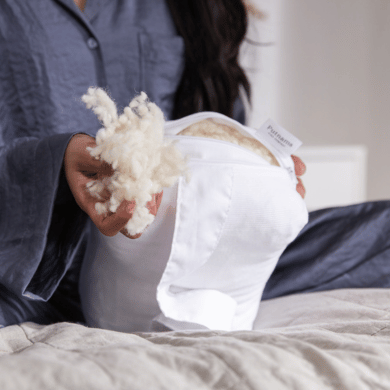
Das „zweite-Wind“-Problem: Warum Sie nachts wach liegen.
Du hattest einen langen Tag. Um 20 Uhr überfällt dich die Erschöpfung wie ein Schlag. Deine Augenlider sind schwer, dein Körper sehnt sich nach Ruhe, und du willst dich nur noch ins Bett verkriechen. Doch dann geschieht etwas Seltsames. Gerade als du dich zum Einschlafen bereit machst, durchströmt dich plötzlich ein Energieschub. Dein Geist ist hellwach, dein Körper fühlt sich unruhig an, und trotz deiner vorherigen Müdigkeit scheint Schlaf unmöglich. Ist das der „zweite Atem“?
Dieses frustrierende Phänomen betrifft Millionen von Erwachsenen, insbesondere diejenigen, die Beruf und Familie unter einen Hut bringen müssen. Der nächtliche Energieschub ist nicht nur lästig, sondern kann die Schlafqualität erheblich beeinträchtigen und am nächsten Tag zu Erschöpfung führen. Zu verstehen, warum dies geschieht und wie man dem vorbeugen kann, verwandelt unruhige Abende in erholsamen Schlaf.
Die gute Nachricht?
Diese nächtliche Wachsamkeit ist kein Zufall und lässt sich mit der richtigen Herangehensweise gut in den Griff bekommen. Indem Sie die biologischen Mechanismen hinter Ihren abendlichen Energieschüben verstehen und gezielte Strategien anwenden, können Sie Ihre Nächte zurückgewinnen und erholt aufwachen.
Was wirklich passiert, wenn man einen zweiten Frühling bekommt
Der Begriff „zweiter Atem“ bezeichnet den plötzlichen Energieschub, den man nach Müdigkeit oder Erschöpfung verspürt. Wenn er nachts auftritt, geschieht dies typischerweise zwischen 21 und 24 Uhr, also genau dann, wenn sich der Körper eigentlich auf den Schlaf vorbereiten sollte. Dieser Zeitpunkt ist kein Zufall; er ist das Ergebnis komplexer Wechselwirkungen zwischen der inneren Uhr und dem Stressreaktionssystem.
Ihr Körper folgt einem komplexen 24-Stunden-Zyklus, dem sogenannten zirkadianen Rhythmus. Dieser reguliert, wann Sie wach und wann Sie müde sind. Ihre innere Uhr schaltet nicht einfach vom Wach- in den Schlafmodus. Vielmehr folgt sie einem fein abgestimmten Muster der Hormonausschüttung im Laufe des Tages.
Die Abendstunden beinhalten naturgemäß einen letzten Anstieg der Wachsamkeit; dies ist die Art und Weise, wie Ihr Körper sicherstellt, dass Sie noch letzte Aufgaben vor dem Schlafengehen erledigen können.
Wenn dieser natürliche Prozess jedoch übertrieben wird oder zu spät einsetzt, wandelt er sich von hilfreich zu störend. Faktoren des modernen Lebensstils verstärken diesen Effekt und schaffen so die perfekte Voraussetzung für unerwünschte nächtliche Energie.
Was ist ein zweiter Wind?
- Definition: Ein plötzlicher, nächtlicher Energieschub oder gesteigerte Wachheit nach einem anstrengenden Tag.
- Wann es passiert: Am häufigsten zwischen 21:00 und 24:00 Uhr.
- Wer ist betroffen? Besonders häufig betroffen sind vielbeschäftigte Erwachsene, die Beruf, Familie und andere Verpflichtungen unter einen Hut bringen müssen.
Welche Auswirkungen hat das auf Sie?
- Erschwert das Einschlafen
- Man fühlt sich am nächsten Tag völlig erschöpft.
- Es unterbricht Ihren Schlafzyklus und macht wahre Erholung unmöglich.
Siehe auch – Die Kunst des erholsamen Schlafs meistern: Wie Sie in 8 einfachen Schritten besser schlafen
Die Rolle von Cortisol und dem zirkadianen Rhythmus
Ihre nächtlichen Wachphasen sind größtenteils auf einen gestörten Cortisolspiegel zurückzuführen. Cortisol und Schlaf vertragen sich einfach nicht. Cortisol, oft auch als „Stresshormon“ bezeichnet, folgt bei gesunden Menschen einem vorhersehbaren Tagesrhythmus. Es erreicht seinen Höhepunkt am frühen Morgen, um das Aufwachen zu fördern, sinkt im Laufe des Tages allmählich ab und erreicht nachts seinen Tiefststand, um den Schlaf zu unterstützen.
Funktioniert dieses System einwandfrei, sinkt der Cortisolspiegel bis zum Abend deutlich, wodurch der Melatoninspiegel, das natürliche Schlafhormon des Körpers, ansteigen kann. Diese hormonelle Umverteilung signalisiert dem Gehirn, dass es Zeit ist, zur Ruhe zu kommen. Chronischer Stress, unregelmäßige Tagesabläufe oder schlechte Schlafgewohnheiten können dieses empfindliche Gleichgewicht jedoch stören.
Bei gestressten Menschen bleibt der Cortisolspiegel bis in die Abendstunden erhöht. Ein hoher Cortisolspiegel hemmt die Melatoninproduktion , wodurch man sich zwar aufgedreht, aber gleichzeitig müde fühlt – körperlich erschöpft, geistig aber hellwach. Das erklärt, warum man sich völlig ausgelaugt fühlt, aber trotzdem nicht abschalten kann, sobald man den Kopf aufs Kissen legt.
Studien zeigen, dass Menschen mit gestörtem Cortisolspiegel ihre wachsten Phasen oft zwischen 22 und 1 Uhr erleben. Wird der natürliche Schlafrhythmus in diesen Stunden verpasst, kann dies einen zweiten Energieschub auslösen, der einen bis in die frühen Morgenstunden wach hält und so einen schwer zu durchbrechenden Kreislauf in Gang setzt.
Siehe auch – Physiologie, Zirkadianer Rhythmus
Abendliche Gewohnheiten, die es verschlimmern
Verschiedene Verhaltensweisen am Abend können nächtliche Wachsamkeit auslösen oder verstärken. An erster Stelle der Liste der Hauptursachen steht die Bildschirmzeit. Smartphones, Tablets, Computer und Fernseher strahlen blaues Licht aus, das Aufmerksamkeit und Reaktionszeit erhöht – genau das Gegenteil von dem, was man vor dem Schlafengehen möchte.
Die Exposition gegenüber blauem Licht hemmt die Melatoninproduktion für mehrere Stunden nach dem Betrachten. Selbst ein kurzes Durchscrollen der sozialen Medien um 21 Uhr kann den natürlichen Schlafrhythmus deutlich verzögern.
Auch die Inhalte, die Sie konsumieren, spielen eine Rolle. Spannende, stressige oder emotional aufgeladene Inhalte, seien es Arbeits-E-Mails, Nachrichten oder Thriller, können Ihr Stressreaktionssystem aktivieren, gerade dann, wenn es sich beruhigen sollte.
Koffeinkonsum nach 14 Uhr stellt einen weiteren bedeutenden Risikofaktor dar. Koffein blockiert Adenosin, eine Substanz, die sich im Laufe des Tages anreichert und Müdigkeit verursacht. Diese Blockade kann 6–8 Stunden anhalten, sodass Ihr Nachmittagskaffee auch um 22 Uhr noch Ihren Schlaf stören und unerwünschte Wachheit in der Nacht hervorrufen kann.
Das absichtliche Aufschieben des Schlafs, trotz Müdigkeit, führt zu einem Teufelskreis. Überwindet man seine natürliche Müdigkeit, interpretiert der Körper dies als Bedürfnis nach erhöhter Wachsamkeit und schüttet Stresshormone aus, um einen wachzuhalten. Was mit „nur noch fünf Minuten Fernsehen“ beginnt, wird zu stundenlangem, ungewolltem Wachsein, begleitet von Gedanken wie „Warum bin ich wach?“.
Körperliche Verspannungen durch eine schlechte Haltung tagsüber können ebenfalls zu nächtlicher Unruhe beitragen. Das ständige Vorbeugen am Schreibtisch, das Überstrecken des Halses zum Bildschirm und die Anspannung in Schultern und Rückenmuskulatur können dazu führen, dass sich der Körper selbst bei geistiger Erschöpfung nicht richtig entspannen kann.
Beachten Sie diese häufigen Auslöser:
-
Bildschirmzeit spät abends
- Blaues Licht hält Ihr Gehirn wach.
- Soziale Medien, E-Mails oder aufregende Shows verstärken Ihre Stressreaktion
-
Koffein nach 14 Uhr
- Die Wirkung kann 6-8 Stunden anhalten und Schläfrigkeit verhindern.
-
Schlafaufschub
- Wenn man die Müdigkeit überwindet, regt das den Körper dazu an, mehr Wachsamkeitshormone freizusetzen.
-
Schlechte Körperhaltung/Verspannung
- Muskelverspannungen können zu Unwohlsein und Unruhe führen.
Siehe auch – Die Kunst des guten Schlafens meistern: 6 wichtige Tipps
Wie Sie Ihren Körper auf die Schlafenszeit vorbereiten
Um den zweiten Windzyklus zu durchbrechen, ist ein umfassender Ansatz nötig, der sowohl Ihre Abendroutine als auch Ihre gesamte Schlafumgebung berücksichtigt. Beginnen Sie damit, eine regelmäßige Entspannungsphase einzuführen, die mindestens zwei Stunden vor Ihrer geplanten Schlafenszeit beginnt. So hat Ihr Körper ausreichend Zeit, sich von den Aktivitäten des Tages auf den Schlaf vorzubereiten.
- Legen Sie eine Technologie-Sperrstunde ein, indem Sie alle Bildschirme 90 Minuten vor dem Schlafengehen ausschalten. Falls Sie Geräte unbedingt nutzen müssen, investieren Sie in eine Blaulichtfilterbrille oder aktivieren Sie den Nachtmodus Ihres Geräts. Ersetzen Sie Bildschirmzeit durch entspannende Aktivitäten wie das Lesen eines Buches, sanfte Dehnübungen oder das Hören beruhigender Musik oder Podcasts.
- Die Temperaturregulierung spielt eine entscheidende Rolle, um Nachschlafattacken vorzubeugen. Ihr Körper kühlt sich im Rahmen der Schlafvorbereitung auf natürliche Weise ab. Unterstützen Sie diesen Prozess, indem Sie Ihr Schlafzimmer zwischen 16 und 19 °C halten und atmungsaktive Bettwäsche verwenden, die zur Regulierung der Körpertemperatur während der Nacht beiträgt.
- Körperliche Verspannungen lassen sich durch gezielte Entspannungstechniken lösen. Progressive Muskelentspannung, bei der systematisch verschiedene Muskelgruppen angespannt und entspannt werden, kann helfen, Bereiche mit gespeichertem Stress zu identifizieren und abzubauen. Sanfte Yoga-Übungen, insbesondere die Kindhaltung oder die Beine-an-der-Wand-Haltung, können das parasympathische Nervensystem aktivieren und die Entspannung fördern.
- Achten Sie auf Ihre Schlafunterlage und Ihr Schlafsystem. Eine schlechte Schlafhaltung kann Verspannungen und Beschwerden verstärken und das Erreichen eines tiefen, erholsamen Schlafs erschweren. Hochwertige Kissen und Unterlagen, die eine korrekte Ausrichtung der Wirbelsäule gewährleisten, können sowohl das Einschlafen als auch die Schlafqualität deutlich verbessern.
- Atemübungen sind ein weiteres wirksames Mittel gegen nächtliche Unruhe. Tiefes, langsames Atmen aktiviert die Entspannungsreaktion des Körpers und hilft, den Cortisolspiegel zu senken. Probieren Sie die 4-7-8-Technik: Atmen Sie vier Sekunden lang ein, halten Sie den Atem sieben Sekunden lang an und atmen Sie acht Sekunden lang aus. Wiederholen Sie diesen Zyklus vier- bis achtmal, um zur Ruhe zu kommen.
Siehe auch – Die militärische Schlafmethode – Ein Zwei-Minuten-Schlafwunder oder nur ein weiterer Hirngespinst?
Produkte, die Ihnen helfen, ruhig und schläfrig zu bleiben
Die richtigen Schlafaccessoires können einen entscheidenden Unterschied machen, um dem Gefühl, vor dem Zubettgehen hellwach zu sein, vorzubeugen und es zu lindern. Diese kleinen, vorbeugenden Maßnahmen können Ihnen helfen, ein waches Gefühl vor dem Schlafengehen zu vermeiden.
- Stützende Kissen , die eine korrekte Nackenhaltung gewährleisten, reduzieren körperliche Verspannungen, die Sie sonst wachhalten könnten. Dank verstellbarer Optionen können Sie die Unterstützung individuell an Ihre bevorzugte Schlafposition und Ihre sich im Laufe der Nacht ändernden Komfortbedürfnisse anpassen.
- Keilkissen erfüllen mehrere Zwecke für einen besseren Schlaf. Durch die leichte Erhöhung kann die Atmung verbessert, Sodbrennen gelindert und die Durchblutung angeregt werden – alles Faktoren, die zu einem erholsameren und ungestörten Schlaf beitragen. Bei Verspannungen in bestimmten Bereichen können gezielte Stützkissen Druckpunkte entlasten, die sonst zu Unruhe führen könnten.
- Temperaturregulierende Bettwaren tragen zu einem optimalen Schlafklima bei. Atmungsaktive Naturfasern, die Feuchtigkeit vom Körper ableiten, verhindern Überhitzung – eine häufige Ursache für nächtliches Aufwachen und anschließendes Einschlafen.
Entscheidend ist, eine Umgebung zu schaffen, die den natürlichen Übergang Ihres Körpers in den Schlaf unterstützt, anstatt ihn zu behindern. Wenn körperliche Beschwerden beseitigt sind und Ihre Schlafunterlage eine gesunde Körperhaltung fördert, kann Ihr Nervensystem leichter in den Ruhemodus wechseln.
Hochwertige Schlafaccessoires ergänzen eine gute Schlafhygiene optimal. Während richtige Abendrituale und Stressbewältigungstechniken die Verhaltens- und psychologischen Aspekte von Müdigkeit und Erschöpfung angehen, sorgt die richtige physische Unterstützung für den nötigen Komfort und damit für einen erholsamen Schlaf.
Die richtigen Produkte können Ihrem Körper und Geist helfen, sanft in den Schlaf zu gleiten:
- Kissen: Bieten gezielte Unterstützung; reduzieren Nacken- und Rückenverspannungen
- Keilkissen: Sie heben und richten den Körper aus und unterstützen so eine leichtere Atmung und bessere Erholung.
- Temperaturregulierende Bettwäsche: Hält Sie die ganze Nacht kühl und trocken.
- Ergonomisches Zubehör: Unterstützt die Wirbelsäulenausrichtung und sorgt für Komfort
Häufig gestellte Fragen
Warum bekomme ich nachts einen zweiten Wind?
Späte Müdigkeit in der Nacht entsteht typischerweise durch einen gestörten Cortisolspiegel und verpasste Schlafphasen. Wenn man seine natürliche Müdigkeit gegen 21-22 Uhr überwindet, schüttet der Körper Stresshormone aus, um wach zu bleiben. Dies führt zu unerwünschter Wachheit, die mehrere Stunden anhalten kann.
Warum bin ich vor allem spät abends wach?
Wenn man sich nachts besonders wach fühlt, deutet das oft auf einen gestörten zirkadianen Rhythmus oder chronischen Stress hin, der den Cortisolzyklus beeinflusst. Der Körper schüttet möglicherweise Wachheitshormone aus, obwohl deren Spiegel eigentlich sinken sollte, und verhindert so die natürliche Abendschläfrigkeit.
Was passiert mit Ihrem Körper, wenn Sie neue Kraft schöpfen?
Beim zweiten Energieschub schüttet der Körper Stresshormone wie Cortisol und Adrenalin aus, die Herzfrequenz, Blutdruck und geistige Wachheit erhöhen. Diese Stressreaktion hemmt die Melatoninproduktion, sodass trotz körperlicher Erschöpfung das Einschlafen schwerfällt. Es sind die körpereigenen Botenstoffe, die nächtliche Energieschübe verursachen und das Einschlafen erschweren.
Kann man mental neue Kraft schöpfen?
Ja, die Ausübung anregender Aktivitäten, seien sie körperlicher, geistiger oder emotionaler Natur, kann die Ausschüttung von Stresshormonen auslösen und so einen zweiten Wind verleihen.
Dazu gehören der Konsum aufregender Medien, das Abrufen von Arbeits-E-Mails, das Führen intensiver Gespräche oder sogar die Sorge, nicht schlafen zu können.
Verändern Sie Ihren Schlaf ab heute Nacht
Das Verständnis Ihrer Schlafmuster nach einer anstrengenden Zeit ist der erste Schritt zu erholsamen Nächten. Die oben genannten Strategien wirken am besten, wenn sie konsequent angewendet werden, damit sich Ihr Körper an die neuen Routinen und Rhythmen gewöhnen kann. Beginnen Sie mit ein oder zwei Änderungen, beispielsweise einer kurzen Auszeit von digitalen Medien und der Optimierung Ihrer Schlafumgebung, bevor Sie weitere Anpassungen vornehmen.
Denken Sie daran, dass die Umstellung etablierter Schlafmuster Geduld erfordert. Ihr zirkadianer Rhythmus und Ihr Stressreaktionssystem brauchen Zeit, sich nach Jahren der Störung neu einzustellen . Seien Sie in dieser Übergangsphase nachsichtig mit sich selbst und freuen Sie sich über kleine Fortschritte, anstatt sofortige Perfektion zu erwarten.
Die Schaffung einer optimalen Schlafumgebung umfasst mehr als nur das Ausschalten des Lichts und das Hinlegen ins Bett. Jedes Element, von der Raumtemperatur über die körperliche Unterstützung bis hin zu den Abendritualen, trägt dazu bei, dass Ihr Körper reibungslos vom Wachzustand in den erholsamen Schlaf übergehen kann.
Verbessern Sie Ihren Schlaf noch heute mit Putnams. Entdecken Sie unser Sortiment an stützenden Kissen, temperaturregulierender Bettwäsche und ergonomischem Schlafzubehör, das entwickelt wurde, um körperliche Hindernisse für einen erholsamen Schlaf zu beseitigen und Ihren Körper auf natürliche Weise in eine ruhige Nacht zu begleiten.
















Hinterlassen Sie einen Kommentar